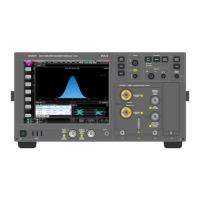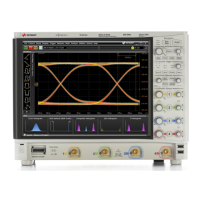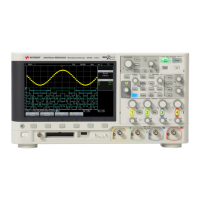58 Keysight InfiniiVision 1200 X-Series and EDUX1052A/G Oscilloscopes User's Guide
5 FFT Spectral Analysis
2 Press the Settings softkey to display additional FFT settings.
• Source 1 — selects the source for the FFT.
• Window— selects a window to apply to your FFT input
signal:
• Hanning — window for making accurate frequency
measurements or for resolving two frequencies that are
close together.
• Flat Top — window for making accurate amplitude
measurements of frequency peaks.
• Rectangular — good frequency resolution and amplitude
accuracy, but use only where there will be no leakage
effects. Use on self-windowing waveforms such as
pseudo-random noise, impulses, sine bursts, and
decaying sinusoids.
• Blackman Harris — window reduces time resolution
compared to a rectangular window, but improves the
capacity to detect smaller impulses due to lower
secondary lobes.
• Vertical Units — lets you select Decibels or VRMS as the units for the FFT
vertical scale.
• Auto Setup — sets the frequency Span and Center to values that will cause
the entire available spectrum to be displayed. The maximum available
frequency is half the FFT sample rate, which is a function of the time per
division setting. The FFT resolution is the quotient of the sampling rate and
the number of FFT points (f
S
/N). The current FFT Resolution is displayed.
Scale and offset considerations
If you do not manually change the FFT scale or offset settings, when you turn the horizontal
scale knob, the span and center frequency settings will automatically change to allow
optimum viewing of the full spectrum.
If you do manually set scale or offset, turning the horizontal scale knob will not change the
span or center frequency settings, allowing you see better detail around a specific frequency.
Pressing the FFT Auto Setup softkey will automatically rescale the waveform and span and
center will again automatically track the horizontal scale setting.

